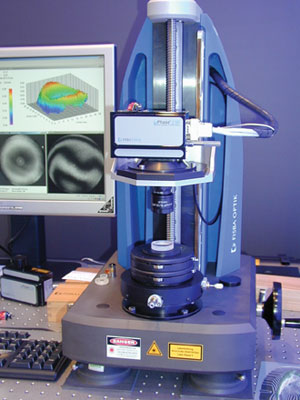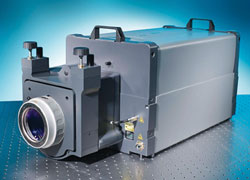For components testing, the Twyman-Green interferometer weighs in against the Fizeau
For the past 100 years or so, makers of optical components have relied on Fizeau interferometers to check surface quality. These devices have allowed manufacturers to detect defects via deviations from regular fringe patterns. However, Fizeau interferometers require very accurate references, which must be tailored for each surface type. Twyman-Green interferometers, however, sidestep this requirement. Not only is the Twyman-Green more flexible, say supporters, but also the need for calibration is no longer relevant. This makes sense for today’s systems, in which electronic processing of the test is standard.

The μPhase manufactured by Fisba Optik is a compact Twyman-Green interferometer.
So which is the stronger argument? – “I only trust what I see,” or “I trust computers in other applications, so why not in optical testing?”
From an optical perspective, the starting point of both devices is the same: a spatially filtered laser source with good coherence properties. In a Fizeau interferometer, the output beam hits a collimating lens that creates a plane wave used for surface testing. Then the beam passes through an angled beamsplitter on the way for coupling out the light on its return path. The key component of a Fizeau interferometer is always the last surface of the test optics, the so-called Fizeau surface, which sits in front of the surface under test. It has a double function: It represents the beamsplitter an interferometer needs, and it defines the reference with which the sample is compared.

Pictured is the VeriFire AT+, a state-of-the-art Fizeau interferometer made by Zygo.
This Fizeau surface must be of very good quality (λ/10 peak to valley or better, which sets an upper limit to measurement accuracy). It must also be the same shape as the surface under test. If the intention is to measure the test surface as a whole (which is usually the case), the reference surface must be the same size. A part of the illuminating beam is reflected by this reference, whereas the other part continues on to the surface to be tested. There, a part is reflected that contains information on aberrations introduced by irregularities of the test surface. The two reflected wavefronts (reflected by the reference and the test surface) interfere with each other on the way back to the light source, and the beamsplitter diverts the interfering beam toward a recording medium, typically a CCD camera.
An argument has been made that a Fizeau interferometer does not require high-quality optics. However, standard interferogram analysis is based on the fact that the wavefront from the test object does not experience any changes from the test optics and is imaged directly to the detector. Consequently, low-quality test optics would not meet that requirement – independent of interferometer type. Therefore commercial versions of both types typically use test optics of λ/2 quality or better.
The Fizeau alternative
Fizeau interferometers have no optical elements between the reference and the tested surface, which is key for generating a pristine interferogram; this is not the case for Twyman-Green-type devices. These interferometers look very much like the well-known Michelson interferometers but generally use more optical elements in the arms, where the beamsplitter is a separate element that generates two individual light paths that are designed to interfere with each other. The reference beam is reflected by a known – and usually fixed – reference surface, returning to the beamsplitter. And as one would expect, the test beam hits the test part and also returns to the beamsplitter, where the beams are reunited to create the interferogram relayed by an imaging lens to the CCD in the observation plane.
The way the Twyman-Green interferogram is generated suggests that the many optical components in both arms can add unwanted aberrations to the result. However, instead of making sure that these components are of perfect quality, the system is turned on its head. Rather than striving for perfection, the process involves zeroing out all errors by a reference measurement, which is mathematically subtracted from the test result. Although this seems much more cumbersome, it isn’t really because in today’s interferometers all data is captured and processed electronically anyway. And it comes with another bonus: Since the calibration does not really care how many aberrations are to be taken out, additional optical elements can be added to the interferometer path to support a more compact design or additional features. Also, if contrast is important, it can be achieved more easily in Twyman-Green setups where the reference can be attenuated to produce similar intensity in both interferometer paths – a job much more difficult to achieve in a Fizeau setup.
Twyman-Green flexibility
The size of the high-quality – and hence expensive – reference surface can be reduced to just a few millimeters in Twyman-Green interferometers by adding (size-converting) optics to the reference arm. Due to the calibration, this reference is usable for various types of surfaces – as opposed to Fizeau interferometers, where a particular and full-size reference is needed for every type of application shape. In a strict sense, Fizeau measurements are limited to surface types for which references exist, whereas Twyman-Green also supports other surfaces. This is the case for aspheric lenses, popular in today’s optical systems, for which computer-generated holograms can be placed into the Twyman-Green. Although this is also possible for Fizeau interferometers, calibration becomes mandatory, making the test effectively the same as the Twyman-Green test – that is, reliant on software operation.
Software is used in all modern interferometers of both types, so that’s not the main difference. However, in the Fizeau case, usually the unprocessed image gives a clue as to how good or bad things are. While this is not the case for the fringe pattern shown by the CCD in a Twyman-Green system, the software has become very fast in yielding the same answer. So how important is this to the user?
“To me, it is not the interferometer type that makes the difference, and whether I can see the result directly or not,” said Robert Daddato, scientist at the European Space Agency (ESA) optics laboratory, which runs several interferometers of both types.
To him, in day-to-day operation, other factors are more important, such as software functionality not related to the interferometer type. When choosing an interferometer – rather than using a service lab like ESA’s – he considers the main factor to be not performance but, for example, the often significant cost of references for testing large surfaces. Objective lenses for a Twyman-Green, on the other hand, are relatively cheap.
“Nevertheless, although I see this as an open race, I think this is almost a matter of taste, where the many traditionalists in the industry [are] sticking to the Fizeau they are used to, and those happy to try something new [are] giving Twyman-Green a go.”